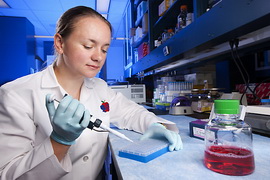
Scientists Use Recombineering to Initiate Site-Directed Mutagenesis
August 17, 2016| |
 Site-directed mutagenesis (SDM) is used to study the resulting translation product for functional characterization. Meanwhile, homologous recombination (HR) is a process where homologous DNA fragments exchanges nucleotides to repair DNA breaks. This mechanism was eventually used to modify plasmids and is now called recombineering.
Site-directed mutagenesis (SDM) is used to study the resulting translation product for functional characterization. Meanwhile, homologous recombination (HR) is a process where homologous DNA fragments exchanges nucleotides to repair DNA breaks. This mechanism was eventually used to modify plasmids and is now called recombineering.
The research team led by Ashutosh Trehan from the University of Turku in Finland presents a single-step method, called REPLACR-mutagenesis (Recombineering of Ends of linearised PLAsmids after PCR), for generating site-directed modifications in plasmids by in vivo recombineering. REPLACR-mutagenesis only involves inserting PCR products into bacteria expressing recombineering proteins.
In REPLACR mutagenesis, primers with the desired mutation are designed to target a specific region in the original vector. A linear PCR product with both ends containing similar sequences is then generated. Bacteria expressing the recombineering proteins are transformed with the PCR product and recombination takes place inside the bacteria, yielding a circular plasmid containing the desired mutation.
For more on this promising technology, read the full article in Nature.
| |
Biotech Updates is a weekly newsletter of ISAAA, a not-for-profit organization. It is distributed for free to over 22,000 subscribers worldwide to inform them about the key developments in biosciences, especially in biotechnology. Your support will help us in our mission to feed the world with knowledge. You can help by donating as little as $10.
-
See more articles:
-
News from Around the World
- Banana Fungus DNA Unravelled; Findings to Lead to Hardier Bananas
- Egyptian Students Organize Biotech Seminars for Sharing Knowledge
- Arctic® Fuji Apple Close to U.S. Regulatory Approval
- Capacity Building Sessions with Biosafety Regulators Held in Pakistan
- New Zealand EPA Declares Glyphosate as Noncarcinogenic
- Scientists Decode Major Pathogen of Barley
-
Research Highlights
- Researchers Engineer White Maize for Astaxanthin Production
- Isoamylase 1 Affects Starch Production and Amylopectin Structure in Durum Wheat Endosperm
-
Beyond Crop Biotech
- BplMYB46 Gene Affects Abiotic Stress Tolerance and Secondary Cell Wall Synthesis in Birch
- Researchers Sequence Tobacco Hornworm Genome
-
From the BICs
- Jordan Hosts Workshop on Plant Biotechnology and Biodiversity
-
Resources
- Biotech Country Facts and Trends
- TEDxUPM Talk on "GMOs: Seeds of Destruction?"
- World Seed Treatment Market Report
-
Plant
- Scientists Use Recombineering to Initiate Site-Directed Mutagenesis
-
Read the latest: - Biotech Updates (December 17, 2025)
- Gene Editing Supplement (December 17, 2025)
- Gene Drive Supplement (February 22, 2023)
-
Subscribe to BU: - Share
- Tweet
